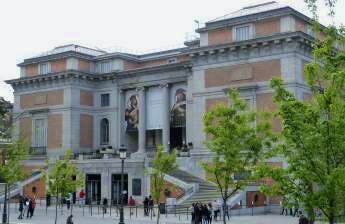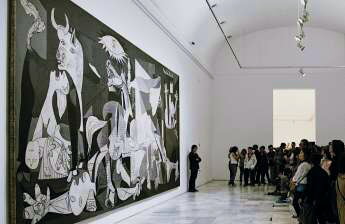The Prado Museum is home to the most renowned Spanish art collection in the world. From the 11th century Mozarabic murals to the 17th-century masterpieces by Goya and Velazquez, this impressive building is a must-visit on any Madrid itinerary.
One of the best ways to see the Prado Museum without getting overwhelmed is by taking a tour with a local guide. This tour will not only save you time by skipping the line, but also provide a unique perspective on each piece of art.
1. The Prado’s Masterpieces
The Prado is one of the world’s greatest art museums. But it’s also a huge place, so you can easily ricochet around unproductively if you don’t have a plan.
To make the most of your time, here’s a list of the must-see masterpieces at the Prado. Use them as a roadmap to navigate your trip and ensure you don’t miss out on anything.
2. The Muhlberg Gallery
The Muhlberg Gallery is a large central hall that houses some of the Prado’s most famous paintings. Among them are the Emperor Charles V at Muhlberg, Titian’s Equestrian Portrait of Charles V and Rubens’ late masterpiece The Adoration of the Magi.
This room also holds works by some of the greatest Spanish painters, including Velazquez’s masterpiece Las Meninas and Goya’s tapestry cartoons. Here, you can immerse yourself in the rich history of Spain’s golden age.
3. The Garden of Earthly Delights
One of the most famous and enigmatic works in the Prado is Hieronymus Bosch’s triptych The Garden of Earthly Delights. The painting has long been interpreted as both a moral warning and a view of a paradise lost to man’s sinful impulses.
This painting is a masterpiece of the Early Netherlandish Renaissance. It is a testament to the painters’ ability to portray surreal images within a Christian framework.
4. The Triumph of Death
The Northern Renaissance artist Pieter Bruegel the Elder explored themes around death in The Triumph of Death. This painting depicts the dance of death, a genre that was common in medieval literature and arts.
In this painting, people are slaughtered by an army of skeletons without cause or warning. The painting demonstrates that death is not only an evil but also an omnipresent force that affects everyone.
5. The Annunciation
The Annunciation, c1425-26, is one of the most important paintings by Fra Angelico. This altarpiece, from the church of San Domenico in Fiesole, was sold and taken to Spain in 1611.
This painting is a great example of the transition from Medieval Gothic to Renaissance style. The figures are delicate and lifelike, the colors are vibrant, and the scenes are filled with the story of the Virgin and her son Jesus Christ.
6. The Descent from the Cross
When you visit the Prado, you’ll be surrounded by paintings by some of Spain’s greatest artists. From Francisco Goya to Diego Velazquez, these works have impacted generations of artists and are worth seeing.
This dramatic painting by Flemish artist Roger van der Weyden was originally painted for the Chapel of Our Lady of Extramuros in Leuven, Belgium. It was acquired by Maria of Hungary and brought to Spain. It later hung in the Chapel at El Pardo and the Monasterio de El Escorial until it was deposited in the Museo del Prado in 1939.
7. The Surrender of Breda
Diego Velazquez’s oil painting, The Surrender of Breda, is one of the most celebrated and important pieces in the museum’s collection. It depicts a historical event that occurred in June of 1625.
During the Dutch War of Independence, Justinus van Nassau surrendered the keys to the city of Breda to General Ambrogio Spinola. Velazquez depicts this moment with equal dignity for both commanders.
8. Las Meninas
Diego Velazquez’s Las Meninas is one of the most famous paintings in the Prado, and a complex masterpiece that defies easy interpretation. In fact, many art historians have spent years trying to decipher its hidden messages.
Set in the Pieza Principal, or Grand Room, of the royal chambers previously occupied by the dead crown prince Baltasar Carlos, Las Meninas features a variety of figures, including the Infanta Margarita Teresa. A group of ladies-in-waiting, a nun and the artist himself are also depicted.
9. The Naked Maya
If you love art that reflects a heightened sense of sexuality, head to the Prado Museum to see an exceptional painting by Francisco Goya. It’s called The Naked Maja and it’s an iconic work from the 18th century.
It’s said to be the earliest Western artwork to depict a nude woman’s pubic hair without obvious negative connotations (such as in images of prostitutes). With this work, Goya upset ecclesiastical authorities, titillated the public and extended the artistic horizon of the day.
10. The Clothed Maya
If you’re a fan of the nude movement, then you’ll want to check out The Clothed Maja (La maja vestida), which Goya painted around 1800. It’s based on his earlier painting, La maja desnuda (1797-1800), and is exhibited next to it at the Prado Museum.
The painting was first owned by Prime Minister Manuel de Godoy, who was known as an avid womanizer. He hung the painting in his home so that it could be revealed at any time with a pulley system.


